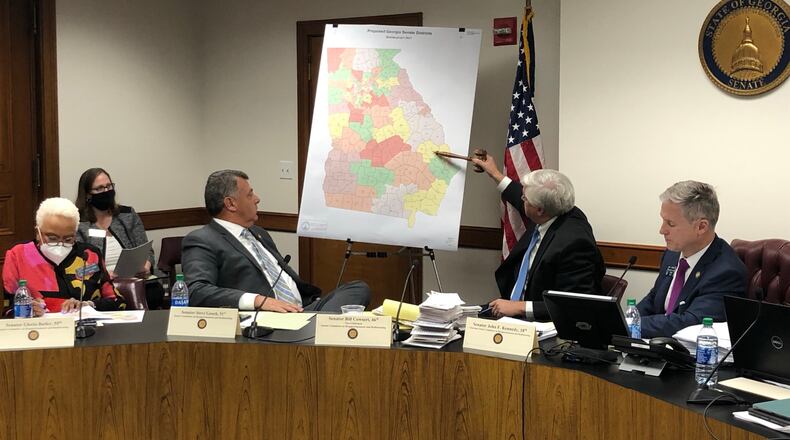A new political map of the Georgia Senate drawn by the Republican majority was poised to clear its committee as soon as Friday, despite objections that it was being rushed just three days after proposed districts were made public.
Leaders of the Senate Redistricting Committee said they planned to move forward with the map after hearing two hours of public comments Thursday critical of a hasty process that continues to lean Republican in a politically split state.
The proposed map would shore up the Senate’s Republican majority, solidifying GOP-held districts while also creating one additional Democratic-leaning district. There are currently 34 Republicans and 22 Democrats in the state Senate.
Advocacy groups seeking a more evenly divided state Senate dominated Thursday’s committee hearing as they asked legislators to slow down and avoid slicing cities into multiple districts.
“We don’t feel like that’s policymaking. This is deck-stacking,” said Stephanie Jackson Ali, policy director for the New Georgia Project, a voter engagement organization that Democrat Stacey Abrams founded. “You’re being able to cherry-pick your voters and skirt the very thing that equal representation would provide, which is accountability.”
But Senate Republicans said they drew a fair map that accounts for Georgia’s population growth of 1 million new residents over the past decade. Each of the Senate’s 56 districts will have about 191,000 residents, with no more than 1% difference in population.
No incumbents of either party were drawn into competition with their peers. Two districts where senators are seeking higher office were dissolved and reformed in high-growth areas, one in Gwinnett County and another near Alpharetta and Roswell in Fulton County. Those districts’ current senators, Republicans Tyler Harper and Bruce Thompson, are running for agriculture commissioner and labor commissioner, respectively.
“We kept petty politics out of it. There was no pairing of incumbents,” said state Sen. Bill Cowsert, a Republican from Athens. “It’s a puzzle fitting all the pieces together.”
Credit: Gina.Wright
Credit: Gina.Wright
Minority Leader Gloria Butler said she will ask the committee to consider a Democratic-drawn map on Friday. Butler’s proposal would create 25 Democratic-leaning districts, 27 Republican-leaning districts and four “competitive” districts that could favor either party.
The General Assembly is controlled by Republicans, making it highly unlikely the Democrats’ proposal would advance.
D.J. Horton, a 13-year-old student from Loganville, asked senators to go back to the drawing board so that his hometown of 12,000 people isn’t divided into three Senate districts, including one stretching from Henry to Morgan counties. District lines also cut through other cities, including Athens, Lawrenceville and Stonecrest.
“I can’t imagine how one would even begin to represent a community so divided,” Horton said. “These maps must not stand.”
While some cities are split up, the Senate map keeps most of Georgia’s 159 counties intact. Twenty-nine counties would have multiple senators, down from the current 39.
The state Senate map will likely become the first to receive a vote since the General Assembly’s redistricting session began two days ago. If it clears committee, then the full Senate could consider the plan.
The state House will begin considering its proposal for 180 districts in committee on Friday.
Congressional maps will be the last to be debated. Senate leaders pitched a map that would help Republicans gain a seat in Congress by shifting boundaries of a district in Atlanta’s northern suburbs held by Democratic U.S. Rep. Lucy McBath. But the House hasn’t yet introduced its congressional map, which might differ from the Senate proposal.
About the Author
Keep Reading
The Latest
Featured



